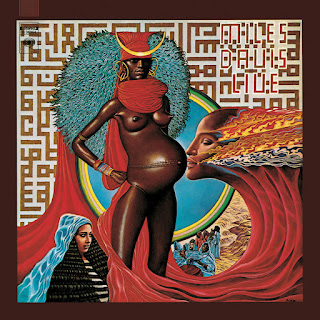By 1971, Davis had already pushed jazz fusion forward in bold, maniacal ways. His first full dive with the brilliant 1969 In a Silent Way might have well been a revolution - a new way forward for jazz as a genre, plugged in with guitars and electric keyboards and incorporating the wild avant-garde nature of contemporaries like the late John Coltrane. The following year's Bitches Brew continued in the direction started by In a Silent Way, but in the place of gentle reflection was wild, angry, and a decidedly almost evil sound. Indeed, Bitches Brew is a wild double album, but it cemented what people were already learning - fusion was the new frontier, and Miles was the vanguard. This collection of live performances, along with three shorter studio tracks, from December of 1970 plays like a more murky, chaotic successor to Bitches Brew, complete with heavy, wild improvisations and a decisively more ominous sound, at least for the live recordings. It's a record that, in many ways, showcases the two halves of Davis that we've seen from his jazz fusion work up to this point - the living, and the evil.
Of the three shorter studio recordings on this album, they sit in stark, juxtaposing contrast to the frantic, menacing sound of the brilliant live performances. The cover of "Little Church," along with "Nem um talvez" and "Selim" aren't sprawling hectic pieces at all, but instead reprises of gentle beauty, not out of place on In a Silent Way. These tracks are amongst his most atmospheric and beautiful that I've heard from him. "Little Church" starts beautiful, but in many ways it becomes haunting as it goes in with Davis' distorted, free trumpet, and yet it sits as a lovely gasp of breath between the frantic "Sivad" and "Gemini/Double Image." The other tracks are played just as straight and tranquilly, with "Nem um talvaez" probably being amongst the album's greatest, and a gorgeous way to end the first disc of the album. Likewise, "Selim" is a brilliant way to open the second disc, almost continuing the ideas from "Nem," while also serving as a perfect juxtaposition to the crazed nature of "Sivad" which opened the album - did you notice how "Sivad" and "Selim" backwards spells "Miles Davis?" This contrast is practically the ethos of the album - these tracks showcases the beautiful; the peaceful; the life.
As for the evil, we get five performances live from The Cellar in Washington D.C., all recorded on December 19, 1970. This is where we get what could easily be called a spinoff of Bitches Brew, albeit one far more rooted in mystical, powerful noise that leans into the ominous, foreboding territory. The live group differs slightly from the studio recordings, and are far more plugged-in and electronic - Davis is howling away on a wah-wah trumpet, for reference. These performances lie in the muddy, murky territory for the most part, driven by the frantic guitar playing of John McLaughlin (who came down for the live performances at the last minute), the uncertain, crunchy fog of Keith Jarrett's organ playing, the sporadic thump of Michael Henderson's bass, and the unhinged soaring style of Miles Davis. Songs become oceans of style and chaos, and on moments like "What I Say" we get the most unhinged style of everyone involved, including a five-minute drum solo from Jack DeJohnette (which is fucking awesome, by the way). Moments like this are often hard to define or talk about, because they're just awe-inspiring and impressive, be it the lowdown groove of "Sivad" that's essentially a variation on "Honky Tonk," or the erupting duel between McLaughlin and Henderson on closing track "Inamorata and Narration by Conrad Roberts," or the raw apocalyptic energy of "Funky Tonk." It all is stuff that must be heard to be believed.
Davis is an artist that rarely disappoints in my book, and he's certainly keeping his brilliant streak going with Live-Evil, which stands as easily one of the most raw and explosive live albums I've heard to date. Of course, his band is no slouch, and every single member gets a chance to showcase their immense talent on this album, and the performances all come together to form an undeniable dichotomy across the album - a clash between the heavenly and the hysterical, the good and the evil. These are explored and executed in very different ways across this album confidently and brilliantly. Live-Evil is a fantastically dense body of work that continues the winning-streak of Miles Davis while also furthering his ideas of jazz fusion to a logical extreme in some cases, a path that he would continuously push with seemingly no end in sight - a brave explorer upon the pioneering trail of what jazz could be.
RATING: ✯✯✯✯✯✯✯✯✯✯
Listen to Live-Evil.

Comments
Post a Comment